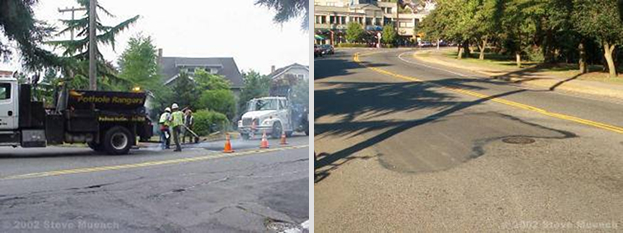Asphalt is the smooth, quiet, durable and sustainable surfacing material that has been around for hundreds of years. Today's asphalt is a scientifically designed product. It is rut, shoving and crack resistant. It is the most recycled material in the world.
(Cont.)
KAPA Pavement Note on Thin Lift Paving
Thin lift paving, such as that seen in non-structural overlays presents several construction concerns (NAPA, 1995):
Thin lifts require less HMA per foot of road length than thick lifts. This can result in high paver speeds (in excess of 70 ft/min) making it difficult for rollers to keep up.
Thin lifts will cool quickly. This can result in little time available for compaction before the thin overlay reaches cessation temperature (sometimes as little as 3 to 5 minutes).
Thin lift construction produces greater screed wear. If the lift depth is less than about twice the maximum aggregate size, the HMA may tear under the paver screed. Very thin lifts (less than 1 inch) can be damaged by the screed dragging large particles.
Thin lifts are more sensitive to vibratory rolling. Incorrectly chosen amplitude, frequency or roller speed can result in aggregate breakage and damage of the bond between the overlay and the existing pavement.
Density control is difficult. Thin lifts provide fewer options for aggregate particles to rearrange under compaction. Thus, mat densities will tend to be less uniform than those associated with a thicker lift. This should be recognized if pay is in any way tied to mat density.
Patches
Patches are a common method of treating an area of localized distress. Patches can be either partial or full-depth, although typically HMA pavement patches are full-depth. A high quality HMA patch can be considered a permanent repair although many patches are done as emergency repairs in poor conditions (e.g., cold, rainy) and therefore are only considered temporary repairs. Patching material can be just about any HMA or cold mix asphalt material as well as certain types of slurries. Typically some form of HMA is used for permanent patches, while cold mix is often used for temporary emergency repairs.
KAPA Pavement Note on Cold Mix Asphalt
Cold mix asphalt is a mixture of aggregate and asphalt emulsion or other proprietary asphalt binder product. Once mixed, the water in the emulsion will evaporate off leaving the aggregate coated with asphalt and ready to use. It is called "cold mix" because, unlike hot mix asphalt (HMA), cold mix asphalt is blended, transported and placed at near-ambient temperatures.
Pothole Patching
Pothole patching probably receives the greatest amount of public attention. Pothole patching procedures cover a wide range of methods and intentions from permanent full-depth patches to temporary on-the-fly patches. However, potholes are the result of pavement failure and therefore any patch is considered temporary until the underlying cause is determined and corrected. Two general patching procedures are described next.
Figure 5: Semi-permanent pothole repair Figure 6: Pothole one year after repair - still performing
Semi-Permanent Pothole Patch (see Figures 5 and 6) (from FHWA, 1998)
Remove all water and debris from the pothole.
Square up the pothole sides so they are vertical and have in-tact pavement on all sides.
Place the patching material into the clean squared-up hole. The material should mound in the center and taper down to the edges so that it meets flush with the surrounding pavement edges.
Compact the patching material starting in the center and working out toward the edges. Compaction can be accomplished using a vibratory plate compactor or a single-drum vibratory roller. Check the compacted patching material for a slight crown. This is done so that subsequent traffic loading will compact it down to the surrounding pavement height.
Throw-and-roll (from FHWA, 1998)
Place the patching material into the pothole without any preparation or water/debris removal.
Compact the patching material using the patching truck tires (usually 4 to 8 passes).
Rehabilitation/Maintenance
The Asphalt Story
(Click on an Article Below)





